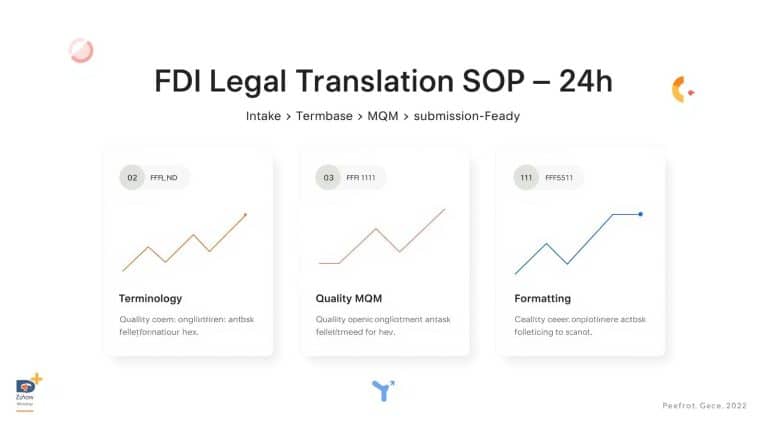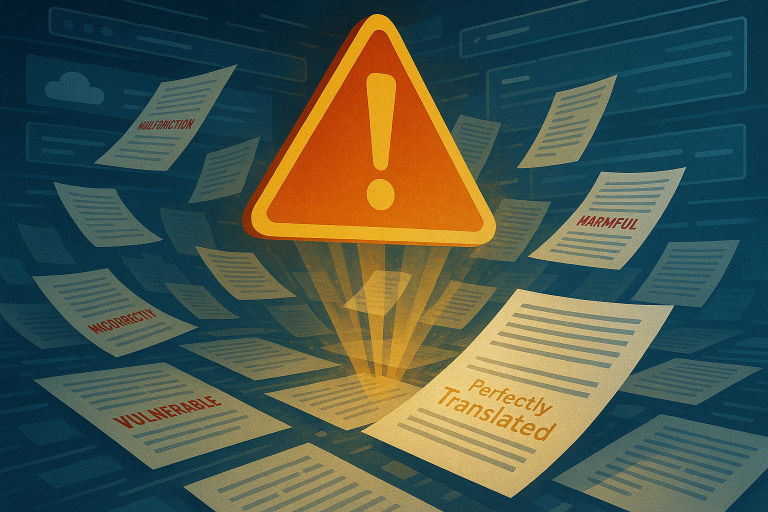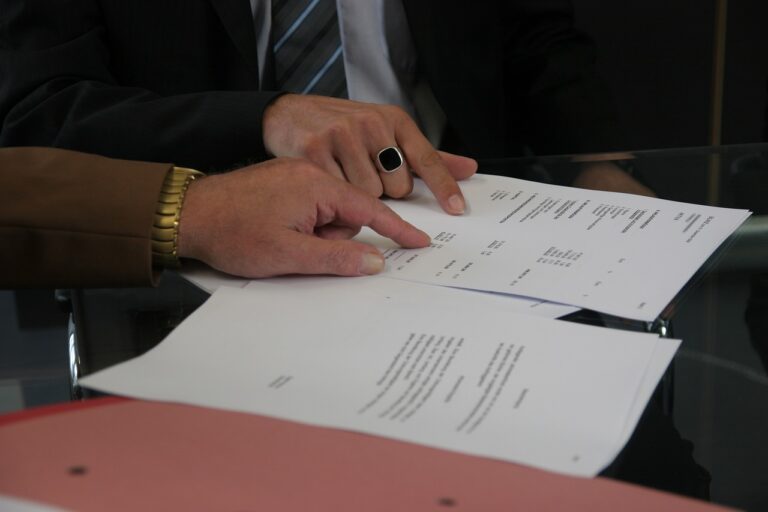1) Why do B2B companies need a “standard bilingual process”?
In a globalized business environment, most operational documents—from contracts, HR policies, and financial reports to technical specifications, sales one-pagers, and email nurture sequences—must be bilingual to: (1) achieve legal alignment, (2) facilitate cross-departmental internal operations, and (3) support international sales. The common bottleneck is not “translating each sentence correctly” but rather ensuring the correct legal/business intent, maintaining terminological consistency, and achieving speed-to-market.
A “Standard B2B Bilingual Process” helps to:
- Shorten go-live time (avoids getting stuck in internal review cycles).
- Reduce revision rounds through the use of a termbase/style guide and quality assurance checks (LQA/MQM).
- Deliver ready-to-use files: clean documents, a change log, and a verification checklist.
- Enable measurement: quality (MQM score), timeliness (24–48h/72–96h SLA), and efficiency (first-pass approval rate, error rate by type).
2) The “Hands-on & Measurable” Principle
Positioning ourselves as “hands-on experts” is not a slogan. It is demonstrated through four working principles:
- Standardize input with a ≤ 2-hour brief: Define the legal/business objectives, target audience, industry context, document scope, deadline/SLA, and approvers.
- Ensure terminological consistency with a termbase & style guide (agreed upon before production).
- Verify quality with LQA/MQM (target ≥ 95/100) instead of relying on subjective assessments.
- Deliver ready-to-use assets: includes a changelog, a term log, and a final “board-ready” version.
3) The 24–48h SOP: 7 Standard Steps (for a standard single-language job)
For multilingual jobs or large volumes, the SLA is extended to 72–96h with a clear role-delegation mechanism.
Step 1 — Brief & Scope (≤ 2h)
- Finalize the business/legal intent, audience, scope, and deadline.
- Gather background materials: original contracts, sample policies/handbooks, template financial reports, technical specs, reference links.
- Confirm the SLA: 24–48h (standard) or 72–96h (multilingual).
Step 2 — Build Termbase & Style Guide (first 3–6h)
- Termbase: Key EN–VI terms, part of speech, domain (Legal/HR/Finance/Tech), definition, example sentence, source, status (Draft/Approved).
- Style Guide: Tone of voice, number & date formats, units of measurement, acronym conventions, spelling, citation rules, table/chart guidelines.
- Alignment Checkpoint: A quick review of 5–10 key items to “lock in” the voice and terminology.
Step 3 — Produce V1 (Context-aware translation/writing)
- Maintain the appropriate industry voice (legalese, plain-language HR, concise technical writing…).
- Add comments where legal/business validation is required.
- Insert placeholders for items needing further information from the client (if any).
Step 4 — Editing & LQA (Target MQM ≥ 95)
- An independent reviewer scores the text against a rubric (accuracy, terminology, style, locale…).
- All errors are tagged (type – severity).
- The revision round focuses on consistency and intent rather than debating stylistic preferences.
Step 5 — Legal/Business Review (for specialized documents)
- Review legal clauses, commercial terms, and approval chains.
- Check for compliance (e.g., e-invoice/VAT clauses in contracts, standard IFRS/VAS naming).
Step 6 — Ready-to-use Delivery
- Clean files, a change log, and an updated terminology log.
- A “board-ready” package: a locked PDF version + an editable version (DOCX/XLSX/Slide).
- A one-page user guide (who revised what, versioning rules).
Step 7 — Post-delivery Review & Internal Machine Learning
- After publication, collect data: review time, issues that arose, feedback.
- Update the termbase/style guide (status to “Approved”) for future jobs.
4) Termbase & Style Guide: The Heart of Consistency
A termbase should contain at a minimum:
- Term (EN) – Term (VI) – Part of Speech – Domain – Definition (EN/VI) – Context Sentence (EN/VI) – Source – Status (Draft/Approved/Deprecated) – Owner/Approver – Last Updated – Notes.
A style guide should define:
- Tone of voice (formal/warm professional/technical concise/plain-language).
- Formatting standards for numbers (decimal separators, thousand separators), dates/months/years, and units of measurement.
- Rules for acronyms/capitalization, citations, and table/chart presentation.
- A voice matrix for different document types (contracts, handbooks, reports, emails).
Practical Impact: Simply “locking in” 20–30 key terms and 5–7 style conventions can immediately reduce revision rounds by 50–60% on the next job.
5) LQA/MQM: Measuring Quality Instead of Subjectivity
MQM/LQA is not meant to “make things difficult” for writers/translators, but to clarify expectations.
- Main error categories: Accuracy, Terminology, Style/Fluency, Locale/Formatting, Omission/Additions.
- Target: MQM ≥ 95/100 for a standard job; scores below the threshold require “Corrective and Preventive Actions” (CAPA).
- Accompanying LQA report: includes error type, frequency, examples, and solutions; the corrected file is attached.
When Legal/HR/Finance teams receive a deliverable with an LQA score and a change log, they can approve it faster because they have a technical basis for review instead of a subjective debate.
6) Governance & Version Control
In B2B enterprises, the question “Which version is the final one?” often causes bottlenecks. Control methods include:
- Source of Truth: Designate a single “/Approved” folder for final, published versions.
- Changelog: For every revision, log: which section, who made the change, why, and the date/time.
- Approval Chain: Requester → Reviewer (LQA) → Owner (Legal/Finance/HR) → Approver (Manager).
- Pseudo-translation (technical method): When a document has many empty fields/placeholders, create a “dummy version” with simulated text to test layout, fonts, Vietnamese diacritics, and line breaks before the final translation is placed into the layout.
7) Multilingual Implementation (2–3 languages)
When expanding to Japanese (JA), Korean (KO), Chinese (ZH), etc.:
- Maintain the English version as the “anchor” or pivot; all other languages should align with it.
- Each language requires an “adapter” who understands the industry context and specific local conventions (especially for legal documents).
- The SLA is typically 72–96h to accommodate an additional checkpoint for the localized termbase and style guide.
- Constraint: Avoid “over-transcreating” legal/financial documents; allow for controlled creativity with marketing/email content.
8) Two Mini-Cases (Anonymous) — With Measurable Results
Case #1 – HR Handbook (FDI, 800 employees)
- Before: A 150-page handbook with many ambiguous terms (e.g., allowance/benefit, suspension/termination), leading to numerous repetitive questions from new hires.
- After: Created a 300-word policy digest, 10 key microcopy sentences, and an updated termbase and style guide; achieved an LQA score of 96/100.
- Results: Repetitive questions decreased by 70%, onboarding time was reduced by 30%, and the approval chain was shortened to just 2 steps.
Case #2 – Contract & E-invoice/VAT (International Supplier)
- Before: Clauses conflated e-invoices with VAT invoices, causing the partner to request multiple revision rounds.
- After: Built a pack of Vietnamese/English clauses, a term log, and a legal review checklist; achieved an LQA score of 97/100.
- Results: The contract was approved in one round, enabling go-live 5 days earlier, with no wording disputes arising.
9) The “Board-Ready” Delivery Package
At the end of a job, the delivery package should include:
- The primary file (DOCX/PDF/XLSX/Slides) + a print-ready locked PDF version.
- A changelog (detailing changes & approvers).
- A log of the terminology used (the termbase with updated statuses).
- A one-page user guide (rules for making revisions post-delivery).
- (If content) A Tone of Voice (ToV) matrix + nurture emails/one-pager ready for CTA insertion.
The goal is to enable the Legal/Finance/HR teams to publish the materials immediately without needing to “re-translate it to their liking.”
Conclusion
A “Standard B2B Bilingual Process” is not about being “fast, cheap, and voluminous.” It’s about correctly serving the legal/business objectives, aligning with the brand voice, and enabling immediate implementation. The difference comes from standardized input (brief), terminological consistency (termbase/style guide), quality measurement (MQM/LQA), and a ready-to-use delivery. When these pieces fall into place, businesses shorten their go-live times, reduce revision rounds, mitigate the risk of misunderstandings, and build an organic lead pipeline from their own operational knowledge.
FAQ:
No. It's a "target score" that helps the team focus on terminology and intent, avoiding subjective debates. Once the termbase/style guide is locked, achieving 95 is entirely feasible.
By applying "disciplined transcreation": legal/financial documents must adhere strictly to the original source; marketing/email content allows for creativity within the "boundaries" of the style guide & ToV.
Start with a mini-termbase of 20–30 key terms and 5–7 style conventions; refine it as you go. After delivery, update it to an "Approved" version.
A "clean file" is the final, ready-to-publish document. An "internal delivery file" also includes logs, highlights, and comments to help the internal team understand the editorial decisions.













